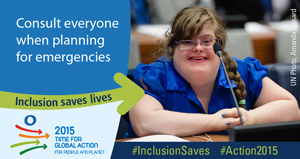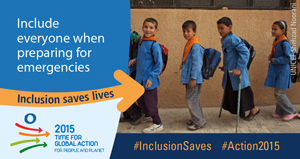Persons with disabilities, when compared to the general population, face higher risks in emergency situations and are disproportionately affected by natural disasters. Available data reveals that the mortality rate of the disabled population is also much higher than that of the non-disabled population in many disaster situations.
People with disabilities have the experience and resilience to help find solutions when planning for disasters and emergencies.
The Third United Nations World Conference on Disaster Risk Reduction (3WCDRR) will take place from 14 to 18 March 2015 in Sendai, Japan. Based on the first Hyogo Framework of Action (HFA), the international community is moving forward with the post-2015 International Framework on Disaster Risk Reduction (HFA2) that will be adopted at the 3WCDRR. This framework will guide and support global efforts at all levels to build nations and communities that are resilient to disasters.
Ensuring the inclusion of persons with disabilities in all aspects of disaster risk reduction efforts can help develop better strategies and save lives in emergency situations.
Think DiDRR: Disability-Inclusive Disaster Risk Reduction!
The purpose of this advocacy campaign "Inclusion saves lives" is:
- To raise awareness of the urgency of disability-inclusive disaster risk reduction and resilience in society and development
- To advance action at all levels to include persons with disabilities, their perspectives, knowledge and experience, in disaster risk reduction and resilience-building.


To read more, please click here.
Source & Copyright: UNDESA DSPD
 Welcome to the United Nations
Welcome to the United Nations